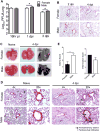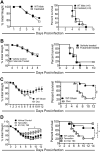Sex-Based Differences in Susceptibility to Severe Acute Respiratory Syndrome Coronavirus Infection
- PMID: 28373583
- PMCID: PMC5450662
- DOI: 10.4049/jimmunol.1601896
Sex-Based Differences in Susceptibility to Severe Acute Respiratory Syndrome Coronavirus Infection
Abstract
Pathogenic human coronaviruses (CoVs), such as the severe acute respiratory syndrome (SARS)-CoV and the Middle East respiratory syndrome-CoV, cause acute respiratory illness. Epidemiological data from the 2002-2003 SARS epidemic and recent Middle East respiratory syndrome outbreak indicate that there may be sex-dependent differences in disease outcomes. To investigate these differences, we infected male and female mice of different age groups with SARS-CoV and analyzed their susceptibility to the infection. Our results showed that male mice were more susceptible to SARS-CoV infection compared with age-matched females. The degree of sex bias to SARS-CoV infection increased with advancing age, such that middle-aged mice showed much more pronounced differences compared with young mice. Enhanced susceptibility of male mice to SARS-CoV was associated with elevated virus titers, enhanced vascular leakage, and alveolar edema. These changes were accompanied by increased accumulation of inflammatory monocyte macrophages and neutrophils in the lungs of male mice, and depletion of inflammatory monocyte macrophages partially protected these mice from lethal SARS. Moreover, the sex-specific differences were independent of T and B cell responses. Furthermore, ovariectomy or treating female mice with an estrogen receptor antagonist increased mortality, indicating a protective effect for estrogen receptor signaling in mice infected with SARS-CoV. Together, these data suggest that sex differences in the susceptibility to SARS-CoV in mice parallel those observed in patients and also identify estrogen receptor signaling as critical for protection in females.
Copyright © 2017 by The American Association of Immunologists, Inc.
Figures







References
-
- Zaki AM, van Boheemen S, Bestebroer TM, Osterhaus AD, Fouchier RA. Isolation of a novel coronavirus from a man with pneumonia in Saudi Arabia. New Engl J Med. 2012;367:1814–1820. - PubMed
-
- Menachery VD, Yount BL, Jr, Debbink K, Agnihothram S, Gralinski LE, Plante JA, Graham RL, Scobey T, Ge XY, Donaldson EF, Randell SH, Lanzavecchia A, Marasco WA, Shi ZL, Baric RS. A SARS-like cluster of circulating bat coronaviruses shows potential for human emergence. Nature Med. 2015;21:1508–1513. - PMC - PubMed
-
- Alagaili AN, Briese T, Mishra N, Kapoor V, Sameroff SC, Burbelo PD, de Wit E, Munster VJ, Hensley LE, Zalmout IS, Kapoor A, Epstein JH, Karesh WB, Daszak P, Mohammed OB, Lipkin WI. Middle East respiratory syndrome coronavirus infection in dromedary camels in Saudi Arabia. mBio. 2014;5:e00884–00814. - PMC - PubMed
-
- Ge XY, Li JL, Yang XL, Chmura AA, Zhu G, Epstein JH, Mazet JK, Hu B, Zhang W, Peng C, Zhang YJ, Luo CM, Tan B, Wang N, Zhu Y, Crameri G, Zhang SY, Wang LF, Daszak P, Shi ZL. Isolation and characterization of a bat SARS-like coronavirus that uses the ACE2 receptor. Nature. 2013;503:535–538. - PMC - PubMed
Publication types
MeSH terms
Substances
Grants and funding
LinkOut - more resources
Full Text Sources
Other Literature Sources
Molecular Biology Databases
Miscellaneous

